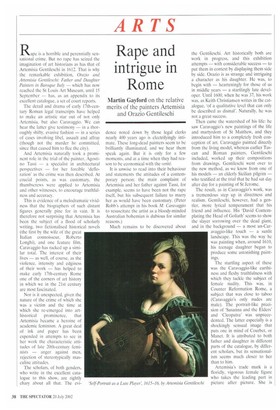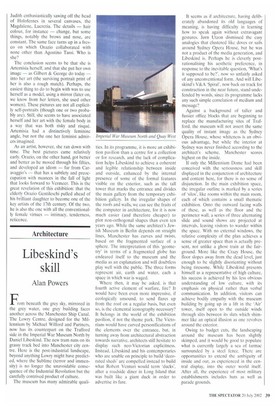Rape and intrigue in Rome
Martin Gayford on the relative merits of the painters Artemisia and Orazio Gentileschi Rape is a horrible and perennially sensational crime. But no rape has seized the imagination of art historians as has that of Artemisia Gentileschi in 1612. That is why the remarkable exhibition, Orazio and Artemisia Gentileschi: Father and Daughter Painters in Baroque Italy which has now reached the St Louis Art Museum, until 15 September — has, as an appendix to its excellent catalogue, a set of court reports.
The detail and drama of early 17th-century Roman legal transcripts have helped to make an artistic star out of not only Artemisia, but also Caravaggio. We can hear the latter give testimony — in a thoroughly shifty, evasive fashion — in a series of cases involving libel, assault and affray (though not the murder he committed, since that caused him to flee the city).
And Artemisia naturally took a prominent role in the trial of the painter, Agosti no Tassi a specialist in architectural perspectives — for her forcible 'defloration' as the crime was then described. At crucial points, as was customary, the thumbscrews were applied to Artemisia and other witnesses, to encourage truthfulness and accuracy.
This is evidence of a melodramatic vividness that the biographers of such distant figures generally pine for in vain. It is therefore not surprising that Artemisia has been the subject of a flood of scholarly writing, two fictionalised historical novels (the first by the wife of the great Italian connoisseur, Roberto Longhi), and one feature film. Caravaggio has racked up a similar total. The interest of their lives — as well, of course, as the violence, intensity and edginess of their work — has helped to make early 17th-century Rome one of the corners of art history in which we in the 21st century are most fascinated.
Nor is it unexpected, given the nature of the crime of which she was a victim and the time at which she re-emerged into arthistorical prominence, that Artemisia became a heroine of academic feminism. A great deal of ink and paper has been expended in attempts to see in her work the characteristic attitudes of late 20th-century feminists — anger against men, rejection of stereotypically masculine attitudes.
The scholars, of both genders, who write in the excellent catalogue to this show, are rightly chary about all that. The evi
dence noted down by those legal clerks nearly 400 years ago is electrifyingly intimate. These long-dead painters seem to be brilliantly illuminated, and we hear them speak again. But it is only for a few moments, and at a time when they had reason to be economical with the verite.
It is unwise to read into their behaviour and statements the attitudes of a contemporary person; the main complaint of Artemisia and her father against Tassi, for example, seems to have been not the rape itself, but his subsequent failure to marry her as would have been customary. (Peter Robb's attempt in his book M: Caravaggio to resuscitate the artist as a bloody-minded Australian bohemian is dubious for similar reasons.) Much remains to be discovered about the Gentileschi. Art historically both are work in progress, and this exhibition attempts — with considerable success — to put them in context by displaying them side by side. Orazio is as strange and intriguing a character as his daughter. He was, to begin with — hearteningly for those of us in middle years — a startlingly late developer. Until 1600, when he was 37, his work was, as Keith Christiansen writes in the catalogue, 'of a qualitative level that can only be described as dismal'. Naturally, he was not a great success.
Then came the watershed of his life: he saw Caravaggio's new paintings of the life and martyrdom of St Matthew, and they introduced him to a completely fresh conception of art. Caravaggio painted directly from the living model, whereas earlier Tuscan and Roman painters, Gentileschi included, worked up their compositions from drawings. Gentileschi went over to the new method, as we know from one of his models — an elderly Sicilian pilgrim — who testified at the trial that he had sat day after day for a painting of St Jerome.
The result, as in Caravaggio's work, was a tremendous step up in directness and realism. Gentileschi, however, had a gentler, more lyrical temperament that his friend and influence. His 'David Contemplating the Head of Goliath' seems to show the slayer sorrowing over the dead giant, and in the background — a most un-Caravaggio-like touch — a sunlit landscape. This was the way he was painting when, around 1610, his teenage daughter began to produce some astonishing paintings.
The startling aspect of these was the Caravaggio-like earthiness and fleshy truthfulness with which they tackle the subject of female nudity. This was, in Counter Reformation Rome, a subject that was close to taboo (Caravaggio's only nudes are male). The portrait-like precision of 'Susanna and the Elders' and 'Cleopatra' was unprecedented. The latter especially is a shockingly sensual image that puts one in mind of Courbet. or Manet. It is attributed to both father and daughter in different parts of the catalogue, by different scholars, but its sensationalism seems much closer to her than to him.
Artemisia's trade mark is a floridly, vigorous female figure who takes the leading part in picture after picture. She is Judith enthusiastically sawing off the head of Holofernes in several canvases, the Magdalene, Lucretia. The details — hair colour, for instance — change, but some things, notably the brows and nose, are constant. The same face turns up in a fresco on which Orazio collaborated with none other than Agostino Tassi. Who is she?
The conclusion seems to be that she is Artemisia herself, and that she put her own image — as Gilbert & George do today — into her art (the surviving portrait print of her is also a rough match). Perhaps, the easiest thing to do to begin with was to use herself as a model, using a mirror (later on, we know from her letters, she used other women). These pictures are not all explicitly self-portraits (though one or two probably are). Still, she seems to have associated herself and her art with the female body in a way that was both risky and risque. Artemisia had a distinctively feminine angle, but not the one her feminist admirers imagined.
As an artist, however, she ran down with time. The best pictures came relatively early. Orazio, on the other hand, got better and better as he moved through his fifties, and developed an idiom — far from Caravaggio's — that has a subtlety and preoccupation with nuances in the fall of light that looks forward to Vermeer. This is the great revelation of this exhibition: that the elderly Orazio Gentileschi pulled ahead of his brilliant daughter to become one of the key artists of the 17th century. Of the two, he is also the one with all the conventionally female virtues — intimacy, tenderness, reticence.



























































 Previous page
Previous page